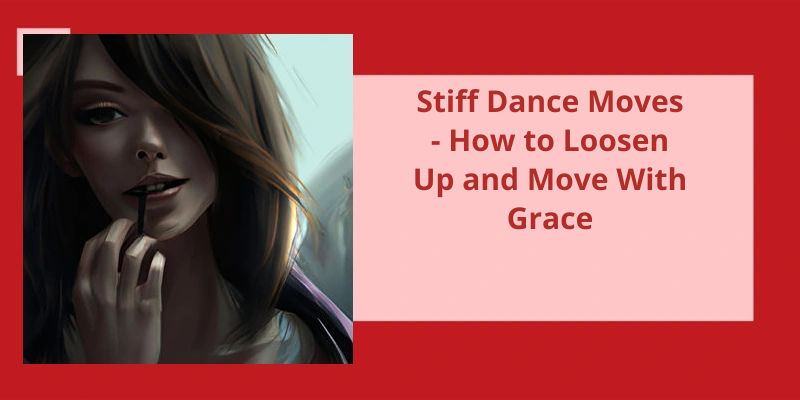Dance is an age-old art form that’s been used for centuries to express emotions and convey messages. It’s a beautiful blend of rhythm, grace, and movement that not only entertains the audience but also allows the performer to connect with their inner self. However, some dance styles require more than just grace and fluidity of movement. Stiff dance moves are a style that demands rigidity and tightness of the muscles, making it one of the most challenging dance forms to master. These moves require immense concentration, physical stamina, and control over the body to execute them flawlessly. Despite the difficulties, stiff dance moves add a unique dimension to the dance world, and when executed well, they can leave a lasting impression on the audience. From popping and locking to robot dancing, stiff dance moves have become an integral part of the dance scene, and their popularity shows no signs of slowing down.
Can You Learn to Dance if You Are Stiff?
It’s important to remember that everyone’s body is unique and different. For some individuals, learning to dance may come naturally and with ease, while for others it may take more time and practice. However, it’s possible for anyone to improve and learn how to dance, even if their body initially feels stiff. Dancing not only strengthens your physical body but also your mind and soul. It’s a joyful and liberating form of expression that anyone can cultivate.
One of the keys to learning how to dance when you’re stiff is to start slowly and gently. Begin with simple movements and gradually build up to more complex ones. This will allow your body to adjust to new rhythms and patterns without feeling overwhelmed or defeated. It’s important to remember that progress takes time and patience, so don’t be discouraged if you don’t see immediate results. Instead, stay committed and keep practicing.
Pay attention to your posture, alignment, technique, and breathing. These elements will help you move with greater ease, reduce the risk of injury, and enhance your overall dancing experience. Additionally, proper alignment and technique can help you achieve greater flexibility and range of motion, which in turn can lead to more fluid and graceful movements.
One way to enhance your dance practice and improve your body’s flexibility and range of motion is to incorporate stretching and conditioning exercises into your routine. Regular stretching can help to mobilize your joints, reduce muscle tension, and increase blood flow to your muscles. Strengthening exercises, such as Pilates or yoga, can help to build muscle strength, stability, and control.
Finally, dance with joy and enthusiasm. Remember that the goal isn’t to be perfect, but rather to fully embrace the experience of movement and self-expression. Dance with your heart and soul, and let your body follow. Celebrate your progress and enjoy the journey, for it’s often in the journey that we discover our true potential, both on and off the dance floor. Absolutely! Just commit to the journey and enjoy the ride.
Now that we know why people tend to look awkward on the dance floor, let’s take a closer look at what it means to be “stiff” in dancing and how to avoid it. By understanding the mechanics of movement and learning how to loosen up, even the most rhythmically challenged among us can begin to feel more graceful and confident on the dance floor.
What Does Stiff Mean in Dancing?
Stiffness in dancing is an important concept that can make or break a dancers performance. Stiffness generally refers to a failure to move fluidly and gracefully, and instead relies on rigid, jerky motions.
Another factor that can contribute to stiffness is locking your knees. When you lock your knees, youre essentially putting all your weight onto your bones, rather than your muscles. This can make it difficult to move and can cause your movements to look jerky and unnatural. To avoid this, always keep your knees slightly bent, which will allow your muscles to do their job and keep your movements smooth.
One area that many dancers tend to overlook when it comes to stiffness is their neck. When we dance, our heads tend to bob up and down, but if our necks are tight or locked up, this motion can be restricted. To avoid this, always make sure to free your neck, letting your head bob slightly with the rhythm of the music. This won’t only help to keep your movements fluid, but it will also help you to stay relaxed and focused while you dance.
By staying in motion, avoiding knee locks, and freeing your neck, youll be well on your way to becoming a more fluid and graceful dancer. With time and dedication, youll be sure to find yourself moving with more ease and confidence on the dance floor.
The Importance of Body Awareness in Overcoming Stiffness in Dance
- Body awareness can help dancers identify areas of stiffness and tension in their bodies.
- Once identified, dancers can use targeted stretching and conditioning exercises to alleviate stiffness and improve mobility.
- Body awareness can also help prevent injury and improve overall technique and performance.
- Regular practice of body awareness techniques, such as yoga and Pilates, can enhance a dancer’s physical and mental well-being.
- By cultivating body awareness, dancers can develop a deeper connection to their bodies and the movement they create, leading to a more expressive and authentic performance.
Now that you’ve a basic understanding of the 6 principles of dance, let’s delve deeper into each one to gain a better understanding of how they form the foundation of dance. These principles include travelling, turning, jumping and leaping, balance and stillness, levels, and gesture. Each of these actions plays a crucial role in creating a beautiful and cohesive dance performance.
What Are the 6 Main Dance Actions?
Dance is a reflection of the human motion as moving bodies interact with the surrounding environment. It’s a creative form of art that incorporates various principles to create fluid motions in response to rhythm and beats. The 6 main principles of dance are fundamental building blocks that mold and shape the movements of various dance genres, including ballet, jazz, hip-hop, and contemporary.
Travelling is a basic form of movement in dance. It involves moving from one location to another, from one spot to another around the dance floor. Dancers use various techniques like walking, running, skipping or sliding to move from one point to another along with the rhythm of the music.
Turning is another principle of dance requiring a rotating movement by the dancer. Spiraling around the vertical or horizontal line of the body is the most common form of turning in many dance styles. The swift and graceful movements of turns are essential to many ballets and contemporary styles. The spins may be carried out during movement or as a standalone sequence.
Jumping and Leaping is all about taking off from one foot and landing on the other. Leaps require longer jumps with one foot forward and one foot back. Jumps include movements like jumps in the air with both feet, hopping on one foot, and galloping dips. It requires immense strength and graceful movements that make an impression in many types of dances.
Balance and stillness involve maintaining a steady pose without much movement. Controlling the balance of the body and retaining stillness can be challenging, and it’s possible for dancers to use movements such as staying on their toes or standing on one leg. Dancers engage their core muscles and center their body weight on a particular area of the body, resulting in impressive feats of balancing.
Levels refer to the height at which the dancer moves their body. It includes movements like jumping, standing, and sitting or squatting. It’s essential to combine various heights, including high, low and medium, to make dances more dynamic and interesting to watch. The use of levels also adds a visual dimension to the show, making it more vibrant and enhancing expression.
Gesturing refers to the dramatic movement of specific parts of the body like the hands or the face to convey a particular emotion. The movements are often more subtle and gentle than other dance movements, and they’re commonly used in ballet and contemporary dances. Gesturing is essential to the art of telling stories through dance, and it’s an excellent medium for showcasing the emotions and expressions of the dancers.
With a combination of these principles, dancers can bring the music to life through their movements, giving audiences an unforgettable experience. Each of these actions engages the body, mind, and soul of the dancers, making it one of the most exhilarating forms of art. Whether it’s travelling, turning, jumping, balancing, gesturing, or changing levels, the principles of dance continue to make it an enduring art form that transcends generations.
How Dance Movements Vary Across Different Cultures and Countries
Different cultures and countries have their own unique dance styles and movements that are influenced by their history, traditions, and beliefs. These differences can be seen in the way dancers use their body, the types of music they dance to, and the meaning behind their movements. For example, traditional Indian dances are characterized by intricate hand gestures and facial expressions, while African dances often involve high leaps and energetic footwork.
Now that we’ve explored some of the most iconic dance moves in history, it’s time to dive deeper and examine what makes a dance move truly great. Some people might argue that it’s all about technical skill and precision, while others might prioritize creativity and originality. Whatever your opinion, there’s no denying that the best dance moves are the ones that make you want to get up and move your body. So, what’re the characteristics of a truly epic dance move? Let’s find out.
What Is the Best Dance Move?
When it comes to dance, there are a multitude of moves to choose from. From classic ballroom steps to high-energy hip-hop routines, there’s no shortage of options when it comes to cutting a rug. However, when it comes to selecting the best dance move of all time, there are a few favorites that stand out above the rest.
Perhaps the most iconic dance move of them all is the moonwalk. This move, popularized by the late Michael Jackson, involves a backwards gliding step that gives the illusion that the dancer is walking on the moon.
Another fan-favorite dance move is the anti-gravity lean. Also made famous by Michael Jackson, this move involves leaning forward at a severe angle without falling over. Using a clever combination of body positioning and footwear, dancers who master this move can achieve a truly mind-bending effect.
For fans of edgier dance moves, the crotch grab is a classic favorite. Popularized by Michael Jackson during his infamous live performances, the crotch grab is a bold move that demands attention. While it’s not for everyone, those who can pull off the crotch grab with confidence can create an unforgettable performance.
Another iconic move comes from Axl Rose, the lead singer of Guns N Roses. His snake dance involves a slithering motion across the stage, arms held high above his head. While it might not be the most technically challenging move, it’s one that’s immediately recognizable and tons of fun to perform.
For those who prefer more classic moves, the twist is a great option. This dance step involves twisting the hips while moving the feet in a simple back-and-forth motion. While it might seem straightforward, the twist has been a go-to dance move for generations and remains a beloved classic.
Finally, for those who love futuristic dance styles, the robot is a must-see move. This style involves jerky, mechanical movements that mimic the motions of a robot. It takes a skilled dancer to pull off this move with precision, but those who do are sure to turn heads on the dance floor.
Overall, when it comes to the best dance move, there’s no one-size-fits-all answer. From legendary moonwalks to daring crotch grabs, there are countless moves to choose from, each with it’s own unique charm and appeal. Whether youre a fan of classic routines or cutting-edge techniques, there’s sure to be a dance move out there that suits your style. So, get out there and start moving!
The Evolution of Dance Over Time and Cultures
Throughout history, dance has evolved over time and is unique to different cultures around the world. Dance styles vary based on the values, beliefs, and artistic expressions of each society. From traditional folk dances to modern choreography, the evolution of dance reflects the continual change and diversity of human culture.
Source: What’s the best dance move ever?..
When it comes to dance, there are many moves that require a great deal of skill and practice to master. From the athletic grace of ballet to the high-energy movements of can-can, each dance style offers it’s own unique challenges. In this article, we will explore some of the most difficult dances in the world and what makes them so challenging.
What Are Some Hard Dance Moves?
When it comes to dance, there are some moves that are just plain difficult. Whether it’s because of the physical requirements or the mental focus needed to execute them flawlessly, these moves are the ultimate test of a dancers skill and dedication. One of the most difficult dance moves is the ballet en pointe technique. This move involves balancing on the tips of the toes, a feat that requires incredible strength and control. Performing this move takes years of training and practice.
Another dance form that requires some serious athleticism is synchronized swimming. This graceful sport involves a team of swimmers performing a choreographed routine in a pool. Synchronicity is key here, as the swimmers have to move as one unit while also holding their breath and maintaining perfect form. This is definitely not a sport for the faint of heart!
Capoeira is known as a martial art, but it’s also considered a dance form. This Brazilian art requires a combination of strength, flexibility, and dance-like movements to execute. The fluid, acrobatic movements involved in capoeira require intense concentration and skill, making it one of the most difficult dances in the world.
Aerial dance is a type of performance that involves performers using fabric, ropes, or other aerial equipment to create stunning displays of acrobatics and grace. The moves involved in this type of dance require incredible strength and flexibility, as well as a high degree of mental focus. From hovering high above the stage to twirling through the air, aerial dancers must have a deep understanding of their own bodies and a strong sense of trust in their equipment.
Finally, we’ve the can-can, a high-energy dance that originated in France in the 19th century. This dance involves a lot of kicks, jumps, and high leg lifts, which require flexibility and stamina. The can-can is often performed at a fast tempo, which means that dancers have to be in top physical shape to keep up.
From Michael Jackson’s iconic performance at the Motown 25th Anniversary celebration, to countless imitations and tributes in music videos, talent shows and parties all over the world, the Moonwalk has become a cultural phenomenon that never fails to impress and delight audiences. But is it really the all-time best dance move? Let’s explore some other contenders and see how they measure up.
What Is the Most Famous Dance Move?
It was popularized by Michael Jackson during his performance of “Billie Jean” during the Motown 25 television special in 198The Moonwalk involves sliding backwards while appearing to walk forwards, with the illusion created by the dancer gliding their feet across the floor. This technique has been used in various dance styles, including hip hop, pop, and breakdancing.
Another iconic dance move is the Twist, which gained popularity in the early 1960s thanks to singer Chubby Checker. The move involves twisting the hips while taking small steps, with the dancer spinning around in a circular motion. The Twist has been a staple at parties and dance clubs for decades and has inspired many other dance styles and variations.
The Running Man is a popular dance move from the 1980s that involves a quick, alternating leg movement while appearing to run in place. The dance was made famous by musician MC Hammer in his music video for “U Can’t Touch This” and has since been incorporated into many other dance styles and routines.
The Electric Slide is a line dance that emerged in the 1970s and gained popularity in the 1990s. The move involves sliding to the left and right while kicking the feet out and bringing them back in. The Electric Slide is a staple at weddings, parties, and other social events and is loved for it’s simplicity and ability to get people of all ages up and moving.
The Macarena is a dance craze that swept the world in the 1990s. The song that accompanies the dance became an international hit and the dance remains popular at parties and events to this day.
Overall, dance is a universal language that brings people together and allows them to express themselves in unique and creative ways. Whether it’s a classic move like the Moonwalk or a trendy new craze, dance will continue to evolve and inspire generations to come.
Conclusion
In conclusion, the art of dance is an absolutely stunning and captivating medium of self-expression that’s been passed down through countless generations and cultures. From the graceful movements of ballet, to the rhythmic grooves of hip hop, there are countless styles of dance that showcase the incredible beauty and diversity of the human body in motion. While some forms of dance may appear more visually impressive than others, it’s important to remember that each style requires a great deal of skill, dedication, and practice to truly master. Whether you’re a seasoned professional or simply someone who loves to move to the beat, the joy of dance is truly universal and can be experienced by anyone who’s willing to embrace it’s power and beauty. So go ahead, put on your favorite tunes, and let yourself loose on the dance floor – because when it comes to expressing yourself through movement, there are no right or wrong stiff dance moves!






